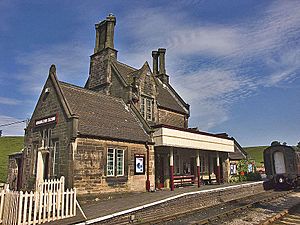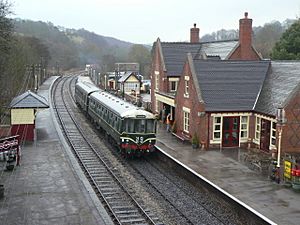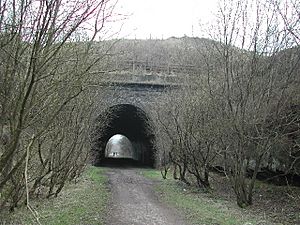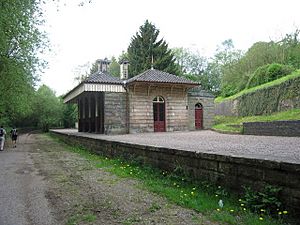Churnet Valley Railway facts for kids
Quick facts for kids Churnet Valley Railway |
|
|---|---|
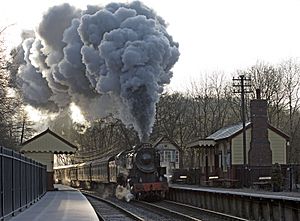
A steam-hauled train at Consall station
|
|
| Commercial operations | |
| Name | British Rail |
| Built by | North Staffordshire Railway |
| Original gauge | 4 ft 8 1⁄2 in (1,435 mm) standard gauge |
| Preserved operations | |
| Owned by |
|
| Operated by | Churnet Valley Railway (1992) plc |
| Stations | 4 |
| Length | 10+1⁄2 miles (16.9 km) |
| Preserved gauge | 4 ft 8 1⁄2 in (1,435 mm) standard gauge |
| Commercial history | |
| Opened | 13 June 1849 |
| Closed to passengers | 4 January 1965 |
| Closed | 30 August 1988 |
| Preservation history | |
| 30 October 1992 | Incorporation of "Goldenlaunch plc" (renamed "Churnet Valley Railway (1992) plc" 15 December 1992) |
| 3 May 1996 | CVR granted light railway order |
| 4 July 1996 | CVR buys Leek Brook - Oakamoor trackbed |
| 24 August 1996 | First service train runs from Cheddleton to Leek Brook |
| 11 July 1998 | Consall station re-opened |
| 11 August 2001 | Kingsley & Froghall station re-opened |
| 13 August 2004 | Consall signal box commissioned, allowing two-train operation |
| 21 September 2008 | Track to Oakamoor Sand Sidings re-open for limited use |
| 12 November 2010 | Cauldon Lowe branch re-opened |
| 6 February 2014 | Ipstones Loop re-opened |
| Website | |
| http://www.churnetvalleyrailway.co.uk | |
The Churnet Valley Railway is a special heritage railway in Staffordshire, England. It's located east of Stoke-on-Trent. This railway uses old tracks from the North Staffordshire Railway's (NSR) Churnet Valley Line.
You can ride regular trains between two main stations. These are Cheddleton and Kingsley and Froghall. Cheddleton is where the trains are kept and fixed. Kingsley & Froghall is where the railway's offices are. There's also a station in the middle called Consall. Some trains go past Cheddleton to Leek Brook Junction and even to Ipstones. However, Ipstones station isn't currently open for passengers.
The railway line is about 10+1⁄2 miles (16.9 km) long. This distance is measured from Kingsley & Froghall station to Ipstones. The section from Leek Brook Junction to Ipstones was opened in 2010. It was first leased by another company, but the Churnet Valley Railway later bought it.
Contents
How the Railway Was Saved
Saving Cheddleton Station (1964–1977)
In the 1970s, a group called the Cheshire and Staffordshire Railway Society (C&SRS) was formed. They wanted to save parts of the old North Staffordshire Railway lines. These lines started closing down in 1964.
The local council planned to knock down Cheddleton station in 1974. But a local businessman, Norman Hancock, stopped the bulldozers by parking his car on the tracks. This delay allowed the station building to be protected as a Grade II listed building. This happened after a campaign by the C&SRS and others.
In 1976, the C&SRS was allowed to use the station building as a museum. The group then changed its name to the North Staffordshire Railway Society (NSRS). Cheddleton station became the Cheddleton Railway Centre. This was the start of the Churnet Valley Railway as we know it. The old goods yard at Cheddleton was bought, and workshops were built. The first locomotives arrived in 1977.
Getting the Tracks Ready (1978–1996)
In 1978, the NSRS became the "North Staffordshire Railway Co. (1978) Ltd". This group became a charity in 1983. In 1984, they bought the bay platform area at Cheddleton. An old signal box from Clifton was moved to the site. This allowed them to run short demonstration trains around the yard.
British Rail stopped using the old Churnet Valley Line in 1988. The NSRC then wanted to buy the section from Oakamoor to Leek Brook Junction. In 1992, the NSRC charity started a new company called Churnet Valley Railway (1992) plc.
In 1996, the company received permission to run trains. This was for a 7 miles (11 km) section between Leek Brook Junction and Oakamoor Sand Sidings. The company also raised money by selling shares to the public in 1995. This helped them buy the land and tracks. The purchase was completed on July 4, 1996.
After this, the tracks were prepared for passenger trains. On August 24, 1996, the first public train ran from Cheddleton to Leek Brook Junction. This was a distance of about 1 mile (1.6 km).
New Stations: Consall and Kingsley & Froghall (1998–2003)
In 1998, more money was raised to upgrade the line south from Cheddleton to Consall. This allowed passenger services to start there on July 11, 1998.
Soon after, the next two-mile (3.2 km) section south to Kingsley & Froghall station was fixed up. This gave visitors another place to park their cars. More money was raised in 2000 to help with this expansion. Even though floods damaged parts of the line in November 2000, the section was ready by August 11, 2001. This allowed regular passenger trains to run the full 5+1⁄4-mile (8.4 km) to Kingsley & Froghall. The rebuilt station building at Kingsley & Froghall was opened on July 19, 2003.
Upgrades and Extensions (2008–2011)
At Kingsley & Froghall station, a second platform was restored in 2008. The wooden waiting shelter was rebuilt to look like the original 1849 design. This restoration project won an award in 2008.
In 2010, 8+1⁄2 miles (13.7 km) of track from Leek Brook Junction to Cauldon Lowe were improved. This allowed passenger trains to run by November. The signal box at Leek Brook Junction was also restored on the outside.
The Railway Route
Most trains on the Churnet Valley Railway run between Kingsley and Froghall station and Cheddleton. They stop at Consall station in between.
From Kingsley & Froghall, the railway passes an old copper factory. It then winds through a forested valley towards Consall. This station is located between the Caldon Canal and the River Churnet. There's a nature park nearby and a pub called the Black Lion. This pub is special because you can only reach it by walking along the canal or the railway. Consall station has a passing loop. This allows two trains to run at the same time during special events.
Trains leaving Consall go up a slight hill towards Cheddleton. This part of the railway is also very wooded. But after about 1⁄2 mile (0.80 km), the trees clear, and you can see open farmland.
When trains arrive at Cheddleton station, they pass the place where locomotives are repaired. You might see trains being fixed in the yard. The old Victorian station building at Cheddleton has a small museum, toilets, and a ticket office. In 2011, a new tearoom was opened on the platform.
From Cheddleton, trains go past a caravan park and through a 531-yard (486 m) tunnel. This tunnel is one of the longest on a UK heritage railway. They then arrive at Leekbrook Junction. This used to be a four-way junction for railways from Stoke, Leek, Alton, and the Cauldon quarries. The old platform for the St Edwards Hospital tramway has been restored. The last remaining signal box from the North Staffordshire Railway is also here. Usually, trains stop here. But on certain dates, trains continue onto the Cauldon Lowe Line for 4+1⁄2 miles (7.2 km) to Ipstones.
The railway also owns the track between Kingsley & Froghall and Oakamoor. The tracks are still there as far as the Oakamoor sand sidings. But they are not good enough for passenger trains yet. To reach Oakamoor railway station, a bridge and a tunnel need to be rebuilt. This is a future goal for the railway.
Signal Boxes
Each station on the railway has a signal box, but only one is fully working:
- Leek Brook: This is the only original signal box still standing on the line. It was restored on the outside in 2014. Plans are being made to make it fully working again.
- Cheddleton: This signal box was moved here in 1978. It helps trains move between the main line and the engine sheds.
- Consall: This signal box was moved to Consall in 2002. It started working in 2004. It's the only fully working signal box on the railway. It allows two trains to run at the same time.
- Kingsley and Froghall: This station never had its own signal box. The one there now is used as a place for catering on busy days. It doesn't have any signalling equipment inside.
How Trains Are Controlled
The railway mostly uses a "one train staff" system. This means only one train can be in a section of track at a time. On most days, the sections between Leekbrook Junction, Consall, and Kingsley & Froghall are linked. This allows a single train to run the whole line. On busy days, Consall signal box is opened. This allows two trains to run at the same time.
Stations You Can Visit
You can get on the train at three stations: Cheddleton, Consall, and Kingsley and Froghall.
- Cheddleton is the main base for the railway. It has the engine shed and workshops where trains are fixed. The old Victorian station building has a museum, a refreshment room, and a ticket office.
- Consall is a small station in the countryside. It has old Victorian buildings and a waiting room. It also has a passing loop for trains.
- Kingsley and Froghall station is newly built. It looks like the old North Staffordshire Railway stations. It has a loop of track for trains to turn around.
The CVR also has tracks at Leek Brook. You can't get to the platform there except by train.
Future Plans
The Churnet Valley Railway has plans to expand!
North Towards Leek
The railway hopes to reopen the line into the town of Leek. They received permission for their plans in 2018. They also got a grant of £1.4 million to help with this project. They hope to build a special "rail triangle" there.
There are also plans to redevelop an area in Leek called Barnfields. This could include a new platform for the railway, a new marina, and a restaurant.
South Towards Alton Towers
To the south, the railway owns the line as far as the old sand sidings at Oakamoor. The tracks need to be upgraded for passengers. To go further, a bridge and the 497-yard (454 m) "Oakamoor Tunnel" would need to be rebuilt. This could lead to Oakamoor railway station and eventually to Alton Towers. Running trains to Alton Towers would be great for tourists visiting the theme park. This is a long-term goal.
A new station called "Moneystone" is also being thought of at the old quarry site. This would connect to a new holiday camp.
West Towards Stoke
West of Leek Brook Junction is the 10-mile (16 km) Stoke–Leek line. This line is currently not in use. The Churnet Valley Railway hopes to use this line for heritage steam trains in the future. If the line could reach Stoke-on-Trent railway station, it would connect with other train services.
In 2012, the CVR announced plans to restore 4 miles (6.4 km) of track from Leek Brook Junction to Endon Station. Volunteers started replacing old sleepers to make the line safe for passengers. Work stopped for a while due to a local dispute, but it was resolved. In 2013, the CVR planned to open a tea room at Endon station. This tea room, called 'The Station Kitchen', opened in 2015.
Annual Steam Galas
The Churnet Valley Railway holds exciting steam galas every year. These events sometimes celebrate special anniversaries for the railway.
- 2014 Gala: Featured home locomotives S160 No. 6046 and LNER Class N7 No. 69621. Guest locomotives included GWR Steam Railmotor No.93 and SR West Country Class No. 34007 'Wadebridge'.
- 2016 Gala: Featured home locomotives TKh49 No. 2944 'Hotspur' and S160 No. 6046. The guest locomotive was GWR 5600 Class No. 5619.
- 2017 (25th Anniversary Gala): Featured home locomotive S160 No. 5197. Guest locomotives included GWR 7800 "Manor" Class 7820 "Dinmore Manor" and GWR 4200 Class No. 4277.
Locomotives
The Churnet Valley Railway has a collection of steam and diesel locomotives. These are the powerful engines that pull the trains.
Steam Locomotives
The railway has several steam locomotives, some are working, and others are being repaired.
- 2944 Hotspur (TKh49 0-6-0): This green locomotive is operational and has covered many miles since its restoration in 2014.
- 5197 (S160 2-8-0): This black locomotive is operational. It was fully restored in 2017 and is famous for its role in "The Polar Express" specials at another railway.
- 6046 (S160 2-8-0): This black locomotive is also operational.
- 44422 (LMS Fowler Class 4F 0-6-0): This locomotive was the first former British Rail steam engine to arrive at the CVR in 1977. It is currently awaiting major repairs.
- 48173 (LMS Stanier Class 8F 2-8-0): This is a long-term project and is currently undergoing restoration.
Diesel Locomotives
The railway also uses diesel locomotives for shunting and sometimes for passenger services.
- Brightside (Yorkshire Engine Company 0-4-0): This black locomotive is operational and is owned by the NSRC.
- 6 Roger H. Bennett (Yorkshire Engine Company Janus 0-6-0): This blue locomotive is operational and is the main shunting engine at Cheddleton.
- 33021 Eastleigh (Class 33): This red locomotive is operational and is on loan from a private owner.
- 33102 Sophie (Class 33): This blue locomotive is operational and was restored in 2012.
Rolling Stock
The railway also has different types of carriages and wagons.
Coaching Stock
The passenger trains use old Mark 1 carriages. They are painted in a maroon color, which was common in the 1950s and 1960s. The railway usually needs one set of these carriages for normal services.
Two Mark 1 carriages are used for the railway's Moorlander dining services. One is a kitchen car, and the other is a dining coach. These coaches were repainted in a special plum and cream color.
Freight Vehicles
The Churnet Valley Railway has a small collection of freight wagons. These are used for special events or for carrying materials needed for the railway.
- Sand Wagon (BR WBB30025 PAA): This is the only remaining sand wagon that was once used to Oakamoor.
- Brake Vans: These include LMS 731790 and Shark Brake Van DB993867.
- Ballast Train: This is a set of wagons used for carrying ballast (stones) for the tracks.
- Box Vans: There are five 4-wheel box vans that are used for photo events.
- Engineers' Wagons: These include a Bogie Bolster and a Parrot wagon, used for engineering work.
- Oil Tanker: A 4-wheel former Esso oil tanker is stored at Leek Brook.
- Ministry of Defence Vehicles: A selection of vehicles bought from the Ministry of Defence are awaiting restoration.
These freight vehicles are not usually advertised for public rides. However, they are sometimes used during special photography events.
Awards
The Churnet Valley Railway has won several awards for its work:
- 2005: Ian Allan Publishing Award for Consall station and signalling, and Kingsley & Froghall station.
- 2008: National Express East Coast Volunteers Award for rebuilding the platform and waiting shelter at Kingsley and Froghall.
- 2013: Winner of "ACES Best Dinner Award 2012".
- 2015: Winner of "Best Use of Production Music in Radio Advertising".
- 2016: Named one of the Daily Mirror Top 10 UK Steam Train Trips.
- 2019: Ranked 9th in Telegraph Travel "Best One-Day Rail Journeys in the World".
Media Coverage
The Churnet Valley Railway has been featured in many TV shows and radio programs:
- In 1983, Simon Groom visited for the BBC show Blue Peter.
- In July 1985, Cheddleton station was used in the BBC series Happy Families.
- In April 2001, Vince Henderson filmed the annual wartime event for Off the Rails on Discovery Real Time.
- In September 2011, the railway was featured on Countryfile.
- In September 2012, the railway's diesel train was on Ashbourne Radio.
- In January 2016, the railway was part of Michael Portillo's Great British Railway Journeys.
- In September 2019, S160 5197 was shown in UKTV's Train Truckers.
Images for kids


